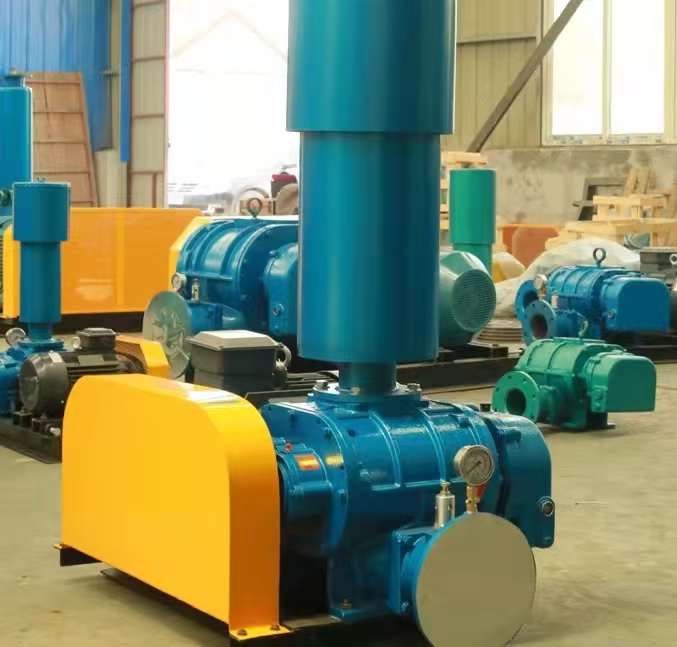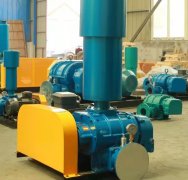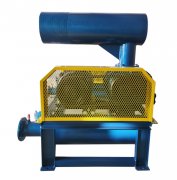**Detailed explanation of the pressure range of Roots blower: from principle to selection guide**
As a type of positive displacement fan, the pressure capacity of Roots blower is one of the core parameters for selection. This article will systematically analyze the pressure generation mechanism, standard pressure range, overpressure risk, and industry application selection of Roots blowers, and provide practical selection suggestions.
---
**1、 Principle of pressure generation for Roots blower**
1. * * No internal compression characteristics**
The Roots blower delivers gas through the meshing motion of two parallel impellers, but the gas is not compressed inside the casing, and the pressure is determined by the system back pressure (the higher the outlet resistance, the higher the pressure).
2. The upper limit of pressure depends on:
-Shell material strength (cast iron/cast steel)
-Rotor clearance accuracy (usually 0.15~0.35mm)
-Motor torque capability
---
**2、 Classification of Standard Pressure Range**
According to the GB/T 8946-2022 standard, the pressure of Roots blowers is divided into three categories:
|* * Pressure rating * * | * * Range (kPa) * * | * * Typical models * * | * * Applicable scenarios * *|
|--------------|----------------|-------------------|---------------------------|
|* * Low pressure type * * | 9.8~49 |/series | Sewage treatment aeration, aquaculture|
|* * Medium pressure type * * | 49~98 |/series | Pneumatic conveying, electroplating tank stirring|
|* * High pressure type * * | 98~196 | Special cast steel shell | Chemical gas recovery, vacuum system front-end|
**Note * *:
-Special design is required for exceeding 98kPa (reinforced bearings/water-cooled shell)
-Ultimate pressure of about 245kPa (cast steel shell+customized rotor)
---

**3、 Comparison of pressure demands in different industries**
|* * Industry * * | * Required Pressure (kPa) * * | * * Key Points for Fan Selection * *|
|------------------|--------------------|-----------------------------------|
|Wastewater treatment aeration | 35-58 | Priority should be given to the 49kPa model, equipped with variable frequency control|
|Powder pneumatic conveying | 58~78 | Medium pressure type+wear-resistant coating impeller|
|Vacuum packaging | -30~-50 (negative pressure) | requires a dedicated vacuum pump model (such as VSR series)|
|Blast furnace blast | 98~118 | High pressure type+water cooling system|
---
**4、 The hazards and protection of pressure exceeding the limit**
1. * * Mechanical damage**
-When the pressure exceeds the rated value of 120, the impeller may collide with the shell (typical fault characteristics: abnormal noise+sudden increase in vibration)
-Case: A chemical plant experienced a pressure increase of 110kPa (rated 80kPa) due to valve misoperation, resulting in an expansion of the impeller clearance by 0.2mm
2. Motor overload**
-When the pressure exceeds 10, the current increases by 15-20
-Protective measures:
-Install valve (action pressure=1.1 times rated pressure)
-Pressure switch linkage shutdown (response time<2 seconds)
---
**5、 Example of Pressure Selection Calculation**
**Working condition requirements * *:
-Transport air volume 15m3/min
-System resistance calculation: total pressure drop of pipeline+dust collector=68kPa
**Selection steps * *:
1. Choose pressure level: 68kPa belongs to the medium pressure range (49~98kPa)
2. Calculate power:
\[
P = \frac{Q \times \Delta P}{6120 \times \eta} = \frac{15 \times 68}{6120 \times 0.7} ≈ 22.4 \, \text{kW}
\]
3. Determine the model: Choose a 30kW medium voltage model (such as CSR-180, pressure range 49~78kPa)
---
**6、 Pressure adjustment method for special working conditions**
1. * * Increase stress**
-Reduce the diameter of the outlet pipeline (motor power needs to be verified)
-Increase the speed (note: the air volume will increase synchronously)
2. * * Reduce stress**
-Add bypass valve (high energy consumption)
-Variable frequency speed regulation (scheme, pressure ∝ speed 2)
---
**7、 Frequently Asked Questions and Answers**
**Q1: Can Roots blower replace centrifugal blower for high-pressure scenarios**
-Not recommended! The efficiency of Roots blower drops sharply when it exceeds 98kPa, and centrifugal blower is more suitable for high-pressure and high flow (such as>196kPa) scenarios.
**Q2: How does the same wind turbine perform in terms of pressure at different altitudes**
-For every 1000m increase in altitude, the pressure decreases by about 10, and the outlet pressure gauge needs to be recalibrated (but the differential pressure capacity of the fan remains unchanged).
---
**8、 Selection Recommendation Table (Mainstream Models)**
|* * Model * * | * * Pressure Range (kPa) * * | * * Airflow (m3/min) * * | * * Compatible Motor (kW) * *|
|------------|--------------------|-----------------------|-------------------|
| CSR-125 | 9.8~49 | 12 | 7.5~15 |
| CSR-200 | 49~98 | 25 | 22~37 |
| CSR-300 | 78~118 | 50 | 55~90 |
|Special CSR-80 | -50~-80 (vacuum) | 8 | 11|
---
**9、 Conclusion**
1. * * Conventional pressure upper limit * *: 196kPa (customized), cost-effective for models below 98kPa;
2. * * Selection core * *: Calculate pressure requirements based on system resistance and reserve 10-15 margins;
3. * * Red line * *: It is strictly prohibited to operate beyond the rated pressure of 20, and pressure protection devices must be installed.
If specific selection support for operating conditions is required, pipeline layout diagrams and gas parameters can be provided for further analysis.



